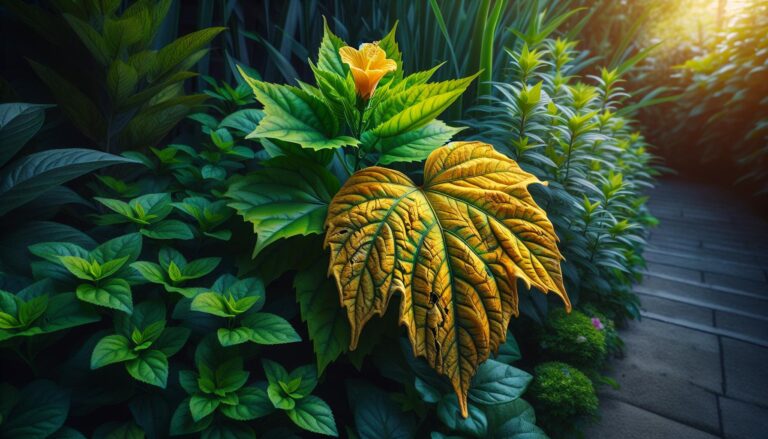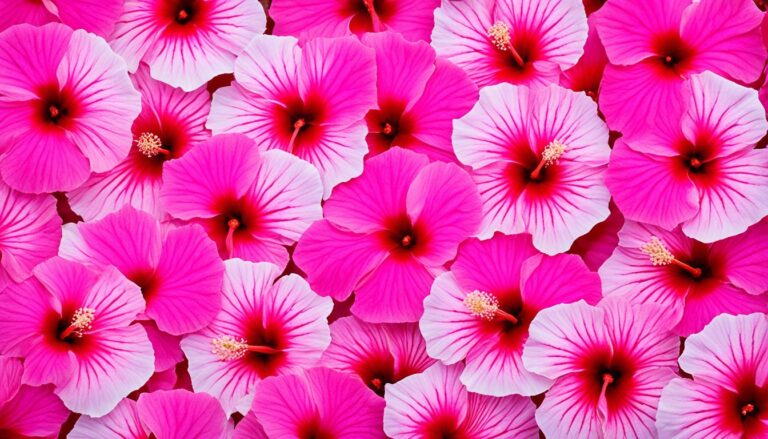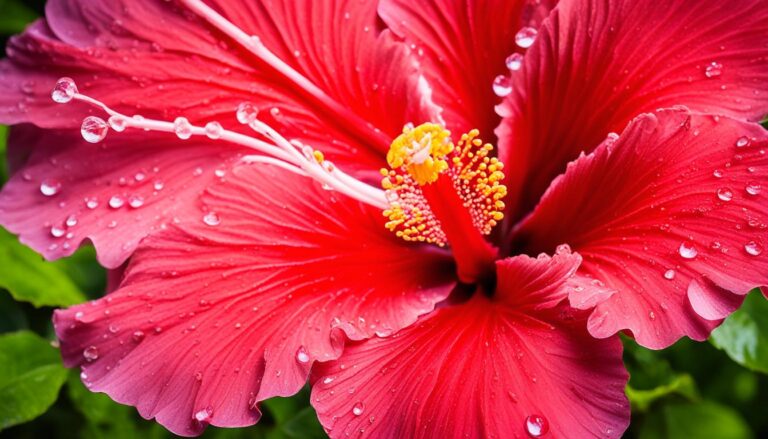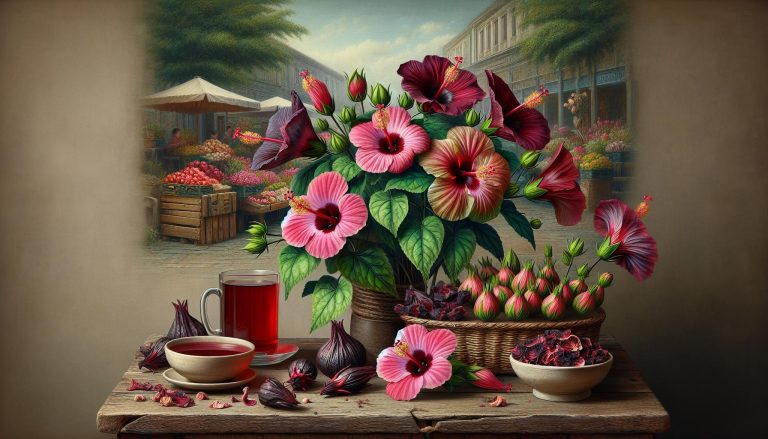When Do Hibiscus Bloom? Gardening Tips for Year-Round Flowers
As garden enthusiasts, we often find ourselves eagerly awaiting the first signs of blooms from our beloved plants. Among these, the hibiscus holds a special place with its large, vibrant flowers that can truly transform a garden space. Understanding when hibiscus bloom is not just about marking calendars; it’s about creating anticipation for the spectacular display of colors that range from pink to blue, and nearly every shade in between.
The blooming season of hibiscus plants is a much-anticipated event, as these bountiful bloomers produce flowers up to 12 inches in diameter, making them a stunning sight. However, the timing and duration of their blooming period can vary significantly depending on the species and the climate they’re grown in. From the cold-hardy varieties that grace us with their presence through most of the summer to the tropical types that require more care, each hibiscus has its own rhythm.
We’re here to shed light on this blooming phenomenon, offering insights into when you can expect your hibiscus to bloom and how to maximize their flowering potential. Whether you’re a seasoned gardener or a curious newcomer, join us as we dive into the world of hibiscus blooms.
Key Takeaways
- Hibiscus plants bloom in a variety of conditions, with tropical types flowering from spring through fall in warm climates, and hardy varieties blossoming from mid-summer to the first frost in cooler zones.
- Selecting the right location, ensuring at least six hours of direct sunlight daily, and preparing the soil with organic matter are crucial for the health and blooming potential of hibiscus plants.
- Proper care, including regular watering, fertilizing with a high potassium and low phosphorus fertilizer, and strategic pruning, is essential for vibrant hibiscus blooms.
- Addressing common challenges, such as pest infestations, nutritional deficiencies, and environmental stress, is key to maintaining the health and flowering capability of hibiscus plants.
- Encouraging hibiscus to bloom involves providing optimal conditions, including full sun, well-draining soil, proper nutrition, and dealing with blooming issues like inadequate sunlight or pest pressures effectively.
- Tropical hibiscus requires overwintering strategies in cooler climates, including reducing water and light gradually and pruning in late winter or early spring to encourage flowering.
Understanding Hibiscus Types
Tropical vs. Hardy Hibiscus
In our exploration of hibiscus blooming, it’s essential to differentiate between the two main types: tropical and hardy hibiscus. Tropical hibiscus, as the name suggests, thrives in warm climates and provides a continuous display of vibrant flowers from spring through fall in frost-free regions. If temperatures drop below 50 degrees Fahrenheit, tropical hibiscus must be brought indoors to survive the winter. On the other hand, hardy hibiscus is suitable for cooler zones, with the ability to withstand freezing temperatures. It comes back each year with impressive blooms from mid-summer until the first frost. This resilience allows hardy hibiscus to be a perennial favorite in temperate gardens, making it a fixture in landscapes beyond tropical zones.
Varieties and Their Bloom Times
Among the hardy varieties, ‘Lord Baltimore’ and ‘Lady Baltimore’ stand out for their large, eye-catching flowers that peak in the mid-to late-summer months. These plants can grow between 4-5 feet tall, offering a spectacular display with their 5-petaled flowers and fused stamens and pistils. For those seeking diversity in color and size, the ‘Disco Belle Mix’ and ‘Kopper King’ variations present a range of hues from white to dark red and unique coppery foliage, respectively. While ‘Disco Belle Mix’ flowers can span up to 10 inches across, ‘Kopper King’ offers a subtler beauty with its 12-inch wide light pink or white flowers featuring a burgundy center.
On the tropical side, options like ‘Anne Arundel’ with its pink flowers and the varied flower colors of ‘Disco Belle Mix’ cater to preferences for both subtlety and flamboyance. These tropical varieties demand more attention, especially in climates that necessitate moving them indoors during cooler months to ensure their survival and blooming capacity.
Understanding the distinctions between tropical and hardy hibiscus, along with familiarity with different varieties and their bloom times, empowers us to make informed decisions in our garden planning. This knowledge not only maximizes our gardens’ aesthetic appeal but also aligns planting strategies with regional climates and individual preferences for flower size, color, and foliage.
Best Planting Practices for Hibiscus
After exploring the world of hibiscus blooms and understanding the differences between the varieties, it’s crucial to dive into the best practices for planting these vibrant plants. By adhering to these guidelines, we ensure that our hibiscus plants not only thrive but also showcase their full blooming potential.
Choosing the Right Location
Selecting an optimal location plays a pivotal role in the success of hibiscus plants. Hibiscus thrives in full sun, requiring at least six hours of direct sunlight daily. This exposure is crucial for the development of the big, bold blooms that hibiscus is known for. Therefore, we recommend planting your hibiscus in a spot that receives ample sunlight throughout the day. It’s also important to consider wind exposure; while hibiscus can tolerate some wind, excessively windy locations can damage the plants and flowers. A sheltered spot, where plants can enjoy the sun without being battered by the wind, is ideal.
Soil Preparation
Soil quality significantly affects the health and flower production of hibiscus plants. Hibiscus prefers well-draining soil rich in organic matter. To prepare the soil for perennial hibiscus, we advise mixing in compost or a soil amendment like Miracle-Gro Garden Soil for Flowers to enhance the soil’s texture and nutrient content. For tropical hibiscus grown in containers, filling pots with a quality potting mix, like Miracle-Gro Moisture Control Potting Mix, ensures proper moisture control and supports healthy growth. Ensuring that the soil pH ranges between 6.5 and 7.5 is beneficial for hibiscus plants, as this pH level optimizes nutrient availability.
When to Plant Hibiscus
Timing is essential when planting hibiscus to set them up for success. For perennial hibiscus, which are hardy and designed to withstand colder climates, the best planting time is in the spring after the threat of frost has passed. This timing allows the plants to establish themselves before the blooming season. Tropical hibiscus, on the other hand, should be planted in late spring to early summer. These varieties, sensitive to cold, benefit from being planted after temperatures are consistently warm. Planting tropical hibiscus at the correct time minimizes stress on the plants, encouraging stronger growth and better blooms. Additionally, gardeners in cooler climates should remember to bring tropical hibiscus indoors during winter months to protect them from the cold.
By following these best practices for planting hibiscus, including choosing the right location, preparing the soil appropriately, and planting at the optimal time, we ensure these stunning plants have everything they need to produce their spectacular blooms.
Essential Care for Hibiscus
After delving into the best planting practices for hibiscus, highlighting the significance of choosing the right location and preparing the soil, we now turn our attention to the essential care these vibrant plants require to flourish. Proper care leads to a stunning display of blooms, ensuring your hibiscus remains a captivating feature in your garden.
Watering and Sunlight Needs
Our care journey begins with understanding the hydration and sunlight requirements of hibiscus plants. Hibiscus thrives in conditions where they receive a minimum of six hours of sunlight daily. This requirement stresses the importance of a strategic planting location, especially to cater to the needs of tropical hibiscus varieties. These plants adore bright, sunny spots, but in regions with intense sunlight, opting for a location that receives filtered light can protect them from scorching.
Regarding watering, hibiscus plants have a pronounced need for consistent moisture. They prefer well-drained, loamy soil that retains moisture without becoming waterlogged. During the growing and blooming seasons, ensuring the soil remains moist but not drenched is paramount. A good rule of thumb is to water deeply and regularly, allowing the water to penetrate the soil deeply, promoting healthy root growth. Moreover, mulching around the plant base can significantly aid in moisture retention, keeping the roots cool and well-hydrated.
Fertilizing for Optimal Growth
To witness the lush growth and vibrant blooms of hibiscus, fertilizing plays a crucial role. Hibiscus plants respond wonderfully to fertilizers high in potassium and low in phosphorus. Our advice is to apply a balanced, slow-release fertilizer designed for flowering plants at the beginning of the growing season. Reapply according to the product’s instructions, usually every few weeks during the active growth period.
For those growing hibiscus in containers, a water-soluble, high-potassium fertilizer might be more suitable, providing nutrients directly to the roots with each watering. Remember, over-fertilizing can harm your plants, leading to fewer blooms and potential root burn, so it’s crucial to follow the recommended application rates.
The Importance of Pruning
Pruning stands as a critical aspect of hibiscus care, enhancing both the plant’s health and its aesthetic appeal. Pruning serves multiple purposes: it stimulates new growth, shapes the plant, and removes any dead or diseased wood. For most hibiscus varieties, the ideal time to prune is early spring, just before new growth begins. This timing allows gardeners to shape the plant effectively and ensures that energy is directed towards producing fresh, healthy foliage and flowers.
When pruning, use clean, sharp tools to make precise cuts just above the nodes where new buds form. Removing old flowers and seed pods can also encourage further blooming, keeping your hibiscus looking its best. Some gardeners also practice light pruning throughout the blooming season to maintain the plant’s shape and encourage a continuous display of flowers.
Through careful attention to watering, sunlight exposure, fertilizing, and pruning, we can ensure our hibiscus plants reach their full potential, gracing our gardens with their spectacular blooms.
Overcoming Challenges
In our quest to unlock the full blooming potential of hibiscus plants, it’s crucial to navigate through common gardening challenges adeptly. These obstacles range from pest infestations to environmental stressors, all of which can dampen the vibrancy and frequency of hibiscus blooms. Let’s delve into understanding these challenges and strategizing effective solutions.
Common Pests and Diseases
Hibiscus plants often fall victim to a variety of pests and diseases that hinder their growth and blooming phases. Aphids, spider mites, thrips, and whiteflies are typical culprits, causing damage manifesting as holes in leaves and petals, premature flower drop, or a general failure to thrive. These pests also secrete a sticky substance, leading to sooty mold. For manageable infestations, a strong water spray can dislodge these pests. In cases of severe or recurring issues, applying an insecticide like Sevin Sulfur Dust proves effective, immediately neutralizing the threat without harming the plant. Additionally, hibiscus is susceptible to diseases such as fungal infections, which are preventable through proper air circulation and avoiding overhead watering.
Managing Yellow Leaves and Bud Drop
Yellow leaves and bud drop are indicators of stress in hibiscus plants. These symptoms can emerge from various sources, including water stress, nutritional deficiencies, or drastic temperature changes, typical when transitioning plants outdoors during the day and back inside at night. Ensuring consistent soil moisture is paramount; hibiscus plants prefer well-draining soil that remains evenly moist. Nutritional balance is also key; a balanced, slow-release fertilizer supports healthy foliage and bud development. If environmental stress is the cause, gradually acclimatizing plants to outdoor conditions by increasing their outdoor exposure incrementally can mitigate shock and prevent bud drop.
Overwintering Strategies for Tropical Varieties
Tropical hibiscus varieties require thoughtful care to overwinter successfully, especially in regions where outdoor temperatures plummet. Before the first frost, transitioning plants indoors for the winter is imperative. Select a bright, cool location inside, aiming for temperatures between 55°F and 70°F. During the winter months, water sparingly, allowing the top few centimeters of soil to dry out between waterings. Pruning in late winter or early spring, by cutting back the plant by one-third, encourages robust growth and flowering in the upcoming season. For best results, gradually reintroduce hibiscus to outdoor conditions in the spring to avoid shock, ensuring a seamless transition outdoors during the day and back inside at night as temperatures stabilize.
By addressing these challenges head-on with informed strategies, we position our hibiscus plants for optimal growth and spectacular blooms. Nurturing these vibrant beauties, though at times demanding, rewards us with a spectacular display of color and life in our gardens.
Encouraging Hibiscus to Bloom
Following the detailed exploration of hibiscus varieties, planting techniques, and maintenance practices necessary for a thriving garden, we’re diving into what can really set your hibiscus apart: achieving spectacular blooms. The success of hibiscus flowering relies on specific conditions and care routines. Let’s explore the optimal conditions for flowering, how to stimulate more blooms, and handle common blooming issues effectively.
Optimal Conditions for Flowering
The foundation for encouraging hibiscus plants to bloom is to provide them with the optimal conditions they crave. Hibiscus flowers flourish in full sun, meaning at least six hours of direct sunlight daily is essential. For locations with harsh afternoon sun, providing some dappled shade can prevent overheating. Soil quality plays a vital role as well, with well-draining, slightly acidic to neutral soil being ideal. Incorporating Miracle-Gro Garden Soil for Flowers can enhance soil conditions, promoting healthier root development and flowering. Ample watering, especially during the growing season, ensures the plants remain hydrated without becoming waterlogged. Temperature-wise, tropical hibiscus varieties prefer warmer climates, while perennial types can withstand a broader range of conditions.
How to Encourage More Blooms
Maximizing bloom production involves a combination of proper nutrition, regular maintenance, and strategic pruning. Feeding hibiscus with Miracle-Gro Water Soluble Bloom Booster Flower Food provides essential nutrients that support vibrant flowers. For container-planted hibiscus, using Miracle-Gro Moisture Control Potting Mix not only aids in optimal root moisture but also encourages healthy flowering. Deadheading, or removing spent flowers, is crucial for promoting continuous blooms by preventing the plant from diverting energy into seed production. Additionally, judicial pruning helps manage plant size and shape, encouraging denser growth and, consequently, more flowers. Bringing tropical hibiscus indoors during colder months without reducing their light exposure too drastically can also help maintain a consistent blooming cycle.
Dealing with Common Blooming Issues
Common issues impacting hibiscus blooming can range from improper care to pest and disease pressure. One prevalent challenge is inadequate sunlight; hibiscus plants not receiving enough light may grow vigorously but produce fewer flowers. Ensuring plants have adequate sun exposure often resolves this issue. Over-or under-fertilization can also lead to blooming problems. Using a balanced fertilizer, like the recommended Miracle-Gro products, aids in preventing these nutrient imbalances. Furthermore, pests such as aphids and spider mites, alongside diseases like fungal infections, can significantly stress plants, impacting their ability to bloom. Effective pest and disease management strategies, including regular inspections and treatment with appropriate products, can mitigate these issues, paving the way for abundant hibiscus blooms.
By addressing these essential factors, we can not only encourage our hibiscus plants to bloom but also ensure they continue to captivate with their stunning flowers season after season.
Conclusion
Unlocking the full blooming potential of hibiscus plants isn’t just about planting them and hoping for the best. It’s about understanding their needs and catering to them meticulously. We’ve walked through the differences between tropical and hardy varieties, the importance of sunlight, soil, and proper care, and how to tackle common issues that might prevent them from blooming. By applying these insights, we’re setting our gardens up for success, ensuring that our hibiscus plants grace us with their stunning flowers year after year. Let’s embrace these practices and watch as our hibiscus plants transform our gardens into vibrant showcases of color and beauty.
Frequently Asked Questions
How do you wake up a hibiscus?
To wake a hibiscus from dormancy, frequently spray its leaves with Wake-Up Spray for 2-6 weeks. Initially, focus on any visible stick part and continue until tiny green buds appear. Continue spraying until tiny leaves start to grow, indicating the plant is waking up.
Do hibiscus like sun or shade?
Hibiscus plants thrive in full sun but can tolerate light shade. The amount of sunlight directly influences flower size and quantity, with plants in more shade producing fewer and smaller flowers. When overwintering indoors, place them near a southern or western facing window for optimal light.
What is the lifespan of a hibiscus plant?
The lifespan of a hibiscus plant varies. Older garden varieties can live up to 50 years, reaching heights of 10-15 feet or more. Newer hybrids may have shorter lifespans, around 5-10 years, and grow more slowly, only a few inches per year.
Do hibiscus come back every year?
Yes, hibiscus plants will return every year. To ensure their return, apply an extended-release fertilizer in late spring as new growth starts. Hibiscus tends to emerge later in the season compared to most perennials, but they will reliably return annualy.
How long does it take for hibiscus buds to flower?
The time it takes for hibiscus buds to flower is relatively short, and they typically bloom within a few days. The exact timing can vary depending on environmental conditions and the specific variety of the hibiscus plant.





